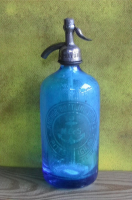








Before the Aspirin was invented in 1898, common digestive problems such as dyspepsia or indigestion were best alleviated with a glass or two of natural volcanic spring water, rich as it is with natural minerals. That said, not everyone had a volcano available when they needed it. It was the curiosity of these naturally effervescent waters that drove initial experimentation into the first carbonated drinks.
Priestly’s apparatus for impregnating water with fixed air
In 1767, the well reputed English chemist Joseph Priestly (who would be better remembered for isolating oxygen in its gaseous state) was the first to artificially carbonate water by hanging a filled vessel over a fermentation vat at a brewery in Leeds (fermentation vats naturally give off CO2 in the process of converting sugars into low alcohol). This initial success led to further experimentation and a published paper entitled, Impregnating Water with Fixed Air. The paper described a means of chemical carbonation by dripping vitriol (sulfuric acid) into powdered chalk (calcium carbonate) producing CO2 gas. This gas was then infused into agitated water, inducing a reaction and effervescence. Even though Priestly didn’t try to market the process commercially he did give the method and ingredients to Captain James Cook on his second voyage to the Pacific, in hope of its ability to alleviate scurvy. Despite the fact this didn’t work, Cook and his crew where potentially the first to produce carbonated water for reasons other than experimentation – albeit not a lot.
Priestley’s paper would however capture the eye of a young German watchmaker in Geneva, Switzerland, who would ultimately bring Priestly’s science to the masses. His name was Johann Jacob Schweppe. After further experimentation, Schweppe was able to simplify carbonation through the application of two common compounds – sodium bicarbonate and tartaric acid. Schweppe branded this process the Geneva System and in 1783, would leave watch-making behind and set up mass production under the new Schweppes brand. These early waters were sold under the guise of medicinal remedies, needless to say the true effects only aided in hydrating patients, not healing them.
After his initial success in Switzerland, Schweppe moved his company to England in 1792 where he set up his first mas production factory in London at 141 Drury Lane, marketing three different strengths of bubbles;
For the dinner table to relieve biliousness (digestion pain).
For patients afflicted with nephritic syndrome (kidney disorder).
For sufferers with violent bladder or kidney stone distress.Schweppes’ product was made all the more unique thanks to a patented torpedo shaped bottle invented by a William Hamilton (c.1814). Initially made out of earthenware, Schweppes discovered that gas slowly escaped through the porous stone and so turned to glass for his solution. Thanks to the round base of the Hamilton, the bottles were stored on their side ensuring the cork stoppers remains wet and therefore retained their swollen seal against escaping gas. These bottles could be initially purchased for 6 shillings, 6 pennies which according to National Archives, equates to around £20.40 in today’s currency. As the secret and popularity of carbonation spread, many replications of the Hamilton bottle were produced but only the original would bear the name Schweppes & Co.
The Hamilton would continue to provide the perfect storage for carbonated water until 1872 when Hiran Codd from Camberwell, London invented a new genius patent. Known as the Codd Neck Bottle or Globe Stopper Bottle, the design utilised a pinched neck containing a marble inside which, once filled with carbonated water, would be pushed against a rubber seal in the spout by the build up of gas, creating an impregnable seal. To prevent the marble getting in the way when pouring, additional pinched stoppers were placed on one side of the neck in which the marble would rest when poured correctly.